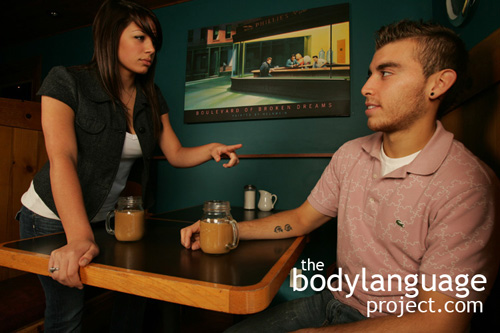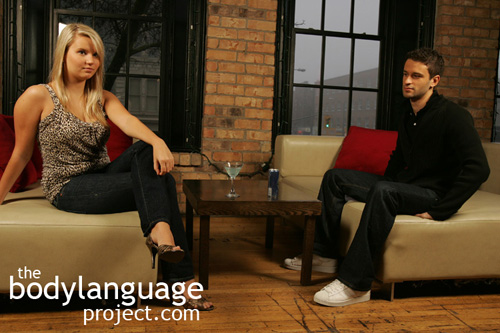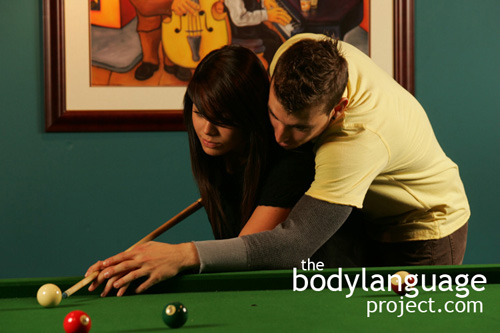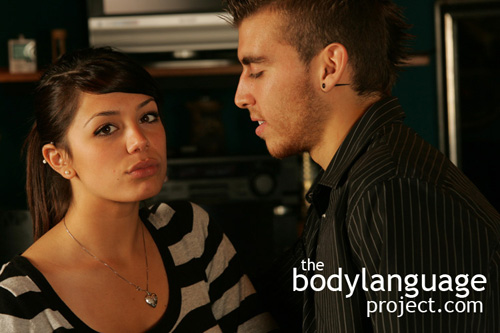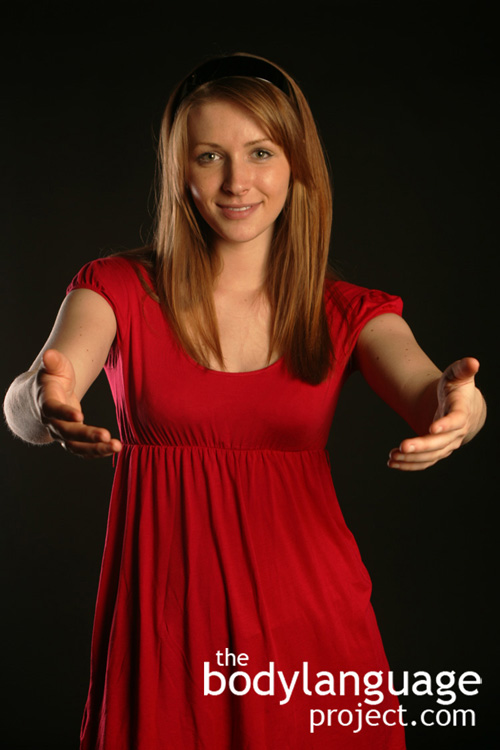Body Language of Bottom Slapping or Bottom Pinching
Synonym(s): Ass Slap, Bum Slap, Bum Pinch, Buttock Clasping
Description: A quick tap on the rear end of another person.
In One Sentence: The bottom slap is a cheeky way to show sexual intimacy or camaraderie.
How To Use it: Use the bottom slap to show your wife that you find her attractive. Women can also use the bottom slap on men they find sexually interesting. The bottom slap is also effective to build trust and companionship between men and women. Therefore, it is useful in a sporting context to build team spirit and create bonds.
Slapping someone on the bum when it is unwelcome can serve to make them uncomfortable and is therefore a power play and an assertion of dominance. This is ill advised as it can result in charges of sexual harassment.
Context: a) Dating b) General.
Verbal Translation: a) “I find you sexually attractive and am paying you an overt compliment.” a) “I own that ass and I’m touching it because I can and you are subordinate to me so you can’t object.” b) “Nice goal you scored there, now we can bond over it with an ass slap in celebration, way to go.”
Variant: Buttock clasping is a sexual display of affection usually done during copulation or while dancing. It is a firm grasping of the rear end. The rear end can be pinched rather than slapped which is universally sexual in nature.
The pinch takes on three forms and has been an Italian “pastime:” the pizzicato which is a quick tweak with the thumb and middle finger, the vivace which is more vigorous and uses several fingers and done more than once and the sostenuto which is prolonged and heavy handed with a rotation.
Cue In Action: a) A man slapped the waitress on the bum as she walked by – it was unwelcomed and was met with an ice cold glare. a) As her husband walked by without a towel after his shower his wife slapped him on the cheeks. b) After scoring a point in volleyball, the two female athletes slapped each other on the butts during a quick embrace.
Meaning and/or Motivation: Usually done by a man on a woman between husband and wife (or vice versa) or dating partners in sexually permissive cultures. At times done to strangers or between people not in a romantic relationship and therefore unwanted and considered sexual assault. It is often done between members of a sports team for bonding.
In a dating context, the bottom slap indicates ownership through touching and sends a sexual signal of interest. At times an ass slap can be seen as a threat display, aggressive in nature and even predatory if unwelcome such as between coworkers in a business setting.
In a sporting context, the bottom slap is to build team spirit and show solidarity and camaraderie. The intent of the bottom pinch or slap is not nearly as important as the feelings attached to it by the recipient and if unwelcome, is a signal of aggression and a threat display, but if welcomed, is a sign of affection and solidarity.
Cue Cluster: a) Usually combined with a cheeky or coy grin and lustful eye contact. When it is unwanted the smile might be more of a smirk with eyes cast toward the person in an objectifying fashion. b) During bonding in sports it is accompanied by other celebration such as arms up postures, excited facial expressions, and loud voices of celebration.
Body Language Category: Courtship display, Enthusiasm (nonverbal), Indicators of sexual interest (IOsI), Liking, Ownership gestures, Power play, Space invasion, Threat displays.
Resources:
Argo, J. J., Dahl, D. W., & Morales, A. C. (2006). Consumer contamination: How consumers react to products touched by others. Journal of Marketing, 70(April), 81–94.
Aranguren, Martin. “Nonverbal interaction patterns in the Delhi Metro: interrogative looks and play-faces in the management of interpersonal distance.” Interaction Studies. 2016. 16(1) forthcoming.
Aranguren, Martin and Stephane Tonnelat. Emotional Transactions in the Paris Subway: Combining Naturalistic Videotaping, Objective Facial Coding and Sequential Analysis in the Study of Nonverbal Emotional Behavior. Journal of Nonverbal Behavior. 2014. 38:495–521. DOI 10.1007/s10919-014-0193-1
http://bodylanguageproject.com/articles/seriously-stop-touching-use-nonverbal-signaling-manage-unwanted-touching-busy-public
Bailenson, J.N. & Yee, N. (in press). Virtual interpersonal touch: Haptic interaction and copresence in collaborative virtual environments. International Journal of Multimedia Tools and Applications.
Bohm. 1997. Effects of interpersonal touch, degree of justification, and sex of participant on compliance with a request. The Journal of social psychology. 137: 460-469.
Curtis, Yvette ; Eddy, Lisabeth ; Ashdown, Brien K. ; Feder, Holly ; Lower, Timothy. Prelude to a coitus: Sexual initiation cues among heterosexual married couples. Sexual and Relationship Therapy. 2012. 27(4): 322-334.
Crusco, A. and C. Wetzel. 1984. The midas touch: the effects of interpersonal touch on restaurant tipping, Personality and Social Psychology Bulletin 10: 512–517.
Debrot, Anik ; Schoebi, Dominik ; Perrez, Meinrad ; Horn, Andrea B. Touch as an interpersonal emotion regulation process in couples’ daily lives: the mediating role of psychological intimacy. Personality & social psychology bulletin. 2013. 9(10): 1373-85.
Feldman, R., Singer, M.,& Zagoory, O. (2010). Touch attenuates infants’ physiological reactivity to stress. Developmental Science, 13(2), 271–278.
Fisher, J; Rytting, M and Heslin, R. 1976. Hands touching hands: affective and evaluative effects on interpersonal touch, Sociometry 39: 416–421.
Fromme, Donald ; Jaynes, William ; Taylor, Deborah ; Hanold, Elaine ; Daniell, Jennifer ; Rountree, J. ; Fromme, Marie. Nonverbal behavior and attitudes toward touch. Journal of Nonverbal Behavior. 1989. 13(1): 3-14.
Greer, Arlettee. ; Buss, Davidm. Tactics for promoting sexual encounters. Journal of Sex Research. 1994. 31(3): 185-201.
Greenbaum, Paul ; Rosenfeld, Howard. Varieties of touching in greetings: Sequential structure and sex-related differences. Journal of Nonverbal Behavior. 1980. 5(1): 13-25.
Gurevitch, Z. D. The Embrace: On the Element of Non-Distance in Human Relations. The Sociological Quarterly. 1990. 31(2): 187-201.
Guéguen, N. (2007). Courtship compliance: The effect of touch on women’s behavior. Social Influence, 2, 81-97.
Guéguen, Nicolas. Nonverbal encouragement of participation in a course: the effect of touching Social Psychology of Education. 2004. 7: 89–98.
http://bodylanguageproject.com/articles/a-touching-way-to-encourage/
Guéguen, N and C. Jacob 2006, Touch and consumer behavior: A new experimental evidence in a field setting, International Journal of Management 23: 24–33.
Gueguen, N. (2001a). Toucher et soumission a` une requeˆte: Re´plications expe´rimentales en situation naturelle et e´valuation de l’impact du statut. Revue Internationale de Psychologie Sociale. 2001(a). 14(3):113-158.
Gue´guen, N. (2001b). L’effet d’influence du toucher sur le comportement du consommateur: 2 illustrations expe´rimentales en exte´rieur. Direction et Gestion: La Revue des Sciences de Gestion. 2001(b). 190–191, 123–132.
Gue´guen, N., & Jacob, C. The effect of touch on tipping: An evaluation in a French’s bar. International Journal of Hospitality Management. 2005. 24(2): 295-299.
Gueguen, Nicolas; Celine Jacob; Gaelle Boulbry. The Effect of Touch on Compliance With a Restaurant’s Employee Suggestion. Hospitality Management. 2007. 26: 1019-1023.
http://bodylanguageproject.com/articles/touching-leads-compliance-study/
Gueguen, Nicolas; Sebastien Meineri and Virginie Charles-Sire. Improving Medication Adherence by Using Practitioner Nonverbal Techniques: A Field Experiment on the Effect of Touch. Journal of Behavioral Medice. 2010. 33:466–473
DOI 10.1007/s10865-010-9277-5
http://bodylanguageproject.com/articles/touching-boosts-compliance-improving-medical-compliance-using-nonverbal-communication/
Hertenstein, Matthew J; Keltner, Dacher; App, Betsy; Bulleit, Brittany A; Jaskolka, Ariane R 2006. Touch Communicates Distinct Emotions. Emotion. 6(3): 528-533
Hall, Jeffrey A. and Chong Xing. The Verbal and Nonverbal Correlates of the Five Flirting Styles. Journal of Nonverbal Behavior. 2015. 39:41–68. DOI 10.1007/s10919-014-0199-8
http://bodylanguageproject.com/articles/first-12-minutes-flirting-using-nonverbal-communication-study-reveals-26-body-language-cues-attraction/
Hosey, Geoffrey ; Thompson, Robin. Grooming and touching behaviour in captive ring-tailed lemurs ( Lemur catta L.). Primates. 1985. 26(1): 95-98.
Hadi, R., and Valenzuela, A., A meaningful embrace: Contingent effects of embodied cues of affection. Journal of Consumer Psychology. 2014. http://bodylanguageproject.com/articles/whats-in-a-nonverbal-object-caress/
Jeffrey D. Fisher; Marvin Rytting; Richard Heslin. 1976. Hands Touching Hands: Affective and Evaluative Effects of an Interpersonal Touch. Sociometry, 39(4): 416-421.
Kaufman, D. and J. Mahoney. 1999 The effect of waitresses’ touch on alcohol consumption in dyads, The Journal of Social Psychology 139: 261–267.
Krishna, A., & Morrin, M. (2008). Does touch affect taste? The perceptual transfer of product container haptic cues. Journal of Consumer Research, 34(6), 807–818.
Kneidinger, L. M.; Maple, T. L.; Tross, S. A. 2001. Touching behavior in sport: functional components, analysis of sex differences, and ethological considerations. Journal of Nonverbal Behavior, 25(1): 43-62.
Kleinke, C. Compliance to Requests Made by Gazing and Touching Experimenters in Field Settings. Journal of Experimental Social Psychology. 1977. 13: 218–223.
Lastovicka, J. L., & Sirianni, N. J. (2011). Truly, madly, deeply: Consumers in the throes of material possession love. Journal of Consumer Research, 38(2), 323–341.
Lynn et al., 1998 M. Lynn, J.M. Le and D. Sherwyn. 1998. Reach out and touch your customers, Cornell Hotel and Restaurant Administration Quaterly 39: 60-65
Maclaren, Kym. Touching matters: Embodiments of intimacy. Emotion, Space and Society. 2014. 13: 95-102.
Moore, Monica. Courtship Signaling and Adolescents: Girls Just Wanna Have Fun. Journal of Sex Research. 1995. 32(4): 319-328.
http://bodylanguageproject.com/articles/girls-just-want-to-have-fun-the-origins-of-courtship-cues-in-girls-and-women/
Nannberg, J., & Hansen, C. Post-compliance touch: An incentive for task performance. The Journal of Social Psychology. 1994.134, 301–307.
Peck, J., & Shu, S. B. (2009). The effect of mere touch on perceived ownership. Journal of Consumer Research, 36(Oct), 434–447.
Peck, J., & Wiggins, J. (2006). It just feels good: Consumers’ affective response to touch and its influence on persuasion. Journal of Marketing, 70(Oct), 56–69.
Remland, M. S. and T. S. Jones 1995. Interpersonal Distance, Body Orientation, and Touch: Effects of Culture, Gender, and Age. Journal of Social Psychology 135(3): 281-297.
R. Stephen and R. Zweigenhaft. 1986. The effect on tipping of a waitress touching male and female customers. The Journal of Social Psychology 126 pp. 141–142.
Rempel, J., Holmes, J., & Zanna, M. (1985). Trust in close relationships. Journal of Personality and Social Psychology, 49, 95–112.
Smith, D. E., Gier, J. A., & Willis, F. N. 1982. Interpersonal touch and compliance with a marketing request. Basic and Applied Social Psychology. 3: 35-38.
Thompson, Erin H. and James A. Hampton. The Effect of Relationship Status on Communicating Emotions Through Touch,. Cognition and Emotion. 2011. 25(2): 295-306. DOI: 10.1080/02699931.2010.492957.
http://bodylanguageproject.com/articles/using-touch-convey-emotion
Williams, L. E., Huang, J. Y., & Bargh, J. A. (2009). The scaffolded mind: Higher mental processes are grounded in early experience of the physical world. European Journal of Social Psychology, 39, 1257–1267.
Williams. 1993. Effects of Mutual Gaze and Touch on Attraction, Mood, and Cardiovascular Reactivity Source: Journal of Research in Personality. 27(2): 170-183.
Willis, F. N., & Hamm, H. K. 1980. The use of interpersonal touch in securing compliance. Journal of Nonverbal Behavior. 5: 49-55.


